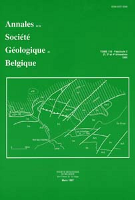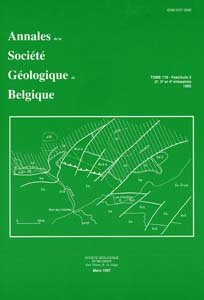- Accueil
- Volume 105 (1982)
- Fascicule 1
- Storm-generated oolitic ironstones of the Famennian (Fa1b-Fa2a) in the Vesdre and Dinant Synclinoria (Upper Devonian, Belgium)
Visualisation(s): 838 (6 ULiège)
Téléchargement(s): 586 (16 ULiège)
Storm-generated oolitic ironstones of the Famennian (Fa1b-Fa2a) in the Vesdre and Dinant Synclinoria (Upper Devonian, Belgium)

Résumé
Quatre niveaux différents à oolithes ferrugineuses ont été reconnus dans le Famennien (Fa1b-Fa2a ; équivalent de la "Nehden Stufe" : do II) du bassin sédimentaire au sud et à l'est du Massif du Brabant. Ces oolithes ferrugineuses représentent des niveaux-repères remarquables à travers les Synclinaux de la Vesdre et de Dinant, et ils peuvent être mis en corrélation avec des sédiments pélitiques ou calcaires rouges/violacés de la région d'Aachen et du bord sud de la Nappe de Dinant. Les oolithes se composent d'allochèmes ferrugineux allochtones, ils surmontent des "hardgrounds", et ils coïncident avec des condensations paléontologiques. Les allochèmes se sont formés dans les différents milieux côtiers (du subtidal peu profond au supratidal), dont ils furent arrachés et transportés ensuite, par action de vagues de tempête. Ce transport est bien illustré par l'évolution latérale des macrofaciès et microfaciès de chaque niveau. Un nouveau modèle est proposé pour l'origine des oolithes ferrugineuses famenniennes. La valeur paléogéographique des niveaux d'oolithes ferrugineuses dans le Massif Ardenno-Rhenan est discutée, comme indicateurs d'activités géotectoniques, d'hiatus stratigraphiques et de dépôts stratiformes métallifères virtuels, associés aux évaporites.
Abstract
Four distinct levels with oolitic ironstones have been recognized within the Famennian (Fa1b-Fa2a ; "Nehden Stufe" equivalent : do II) of the sedimentary basin S and E of the Brabant Massif. These oolitic ironstones represent useful marker beds throughout the Vesdre and Dinant Synclinoria and they may be correlated with red/purple-stained shales and limestones of the Aachen area and of the southern borders of the Dinant Nappe. The ironstones consist of allochtonous ferruginized allochems, they surmount hardgrounds and coincide with paleontological condensations. The allochems originated in the different environments of a coastal area (shallow subtidal to supratidal) from which area they have been removed and subsequently been transported by storm wave events (turbid surficial clouds) to the open shelf. This transport is well-illustrated by the lateral evolution of macro- and microfacies. A working model for the origin of the Fammennian oolitic ironstones is proposed. The paleogeographic value of the oolitic ironstones as indicators of geotectonic activities, stratigraphic hiatus and virtual evaporite-associated metalliferous deposits within the Ardenno-Rhenish area is discussed.






